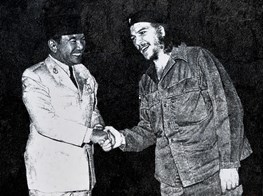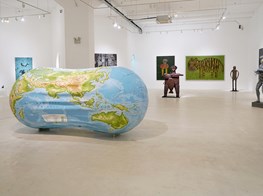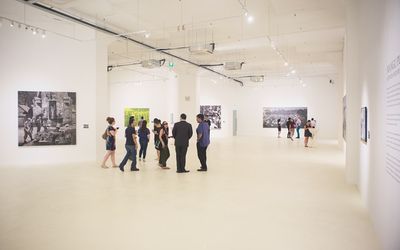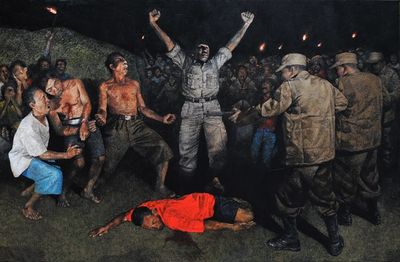Mangu Putra at Gajah Gallery
Earlier in your career, your paintings focused more specifically on your direct environment, Bali. Now your research considers the national history of Indonesia. What prompted this shift to exploring the broader historical and political landscape of your country?
Mangu Putra. Image courtesy Gajah Gallery, Singapore.
Nature is an endless source of inspiration for me, both in its beautiful, pristine state and its most polluted state. The works I produce from historical explorations depict a dialogue between my thoughts and feelings towards what I have read and observed during my research. So my works reflect my personal perception of what has happened in history. My paintings are not meant to inform, but rather to share my feelings and thoughts through art. It is not my way of dictating the relevance of these issues.
As part of the research for your current series of paintings, you interviewed veterans and visited key historical areas relating to the Indonesian War of Independence (1945 – 1949). What effect did this real-time contact with the people and places you were researching have on your artworks?
I’m interested in digging into historical archives because they document important national struggles against colonialism. However, I am aware that not every single detail is documented in these archives. The interviews I conducted informed me of personal stories, ones which are never written in history books and were never documented. Through these, I get to infuse a sense of a personal story into my paintings, and to create a space in history for these people and heroes whose stories are forgotten by the books and archives.
What has been the response to your paintings from those you have interviewed?
Many of the veterans I interviewed are still related to me through networks of extended family or clan, and it is not difficult for me to understand what they went through. One of the veterans I interviewed stated that he felt relieved after telling me his long-abandoned opinions on the war, and he passed away shortly after the interview. I guess I am grateful that my research for this exhibition can be a platform for reflection and contemplation for these veterans.
You have exhibited in many countries internationally, including South Korea, China, and Australia, as well as Indonesia. Each of these countries has a very particular political history. How do you think the reading of your art, which works very closely with Indonesian political history, changes when presented internationally?
Themes such as war and colonialism resonate universally. Viewers might not be familiar with the specific war such as the Puputan War [mass ritual suicides that occurred in preference to surrender in 1906 and 1908 when the Balinese were being subjugated by the Dutch], of which my paintings are about, but it would trigger them to reflect on similar conflicts that their respective countries have gone through. It is part of a shared experience we all have about conflicts of power, fighting for independence, military violence, and so on.
You’re trained in graphic arts and design, and you originally worked in advertising. What made you decide to change careers and become a contemporary artist? Was there a particular moment or event that prompted the move?
Visual arts gave me the freedom to express myself, while with graphic design I need to follow a set 'rule' of design principles. Technically, a big part of my work is influenced by design. Distorted prints, rough 'noise' and dots resulted from the process of photocopy, and blurred photographs; they all in a way inspire me.
Most of your paintings from this series are based on archived photographs. What was the thought process behind the decision to translate the collected images from photograph to painting?
I chose to utilise archival photographs because these visuals gave me a deeper source of inspiration. While observing photographs of these historical events, I reimagined those events and translated my observations on my canvas.
What is the process of selection when choosing the photographs you paint?
I select images based on what I think is aesthetically pleasing. Also based on the unique quality of certain events depicted in the photographs, such as the image for the painting Transit? (2016), which depicts an image I discovered while researching the mysterious landing of a Nazi plane in Bali in 1938.
Your 2016 painting Eksekusi Letda Reta depicts the execution of Letda Reda, your uncle, who fought in the war for independence alongside your father. Your father survived the execution but your uncle did not. This of course would have been a particularly personal event for you to portray. What do you believe is the role of your personal perspective in this series and its exploration of Indonesia’s history?
To offer an alternate point of view of certain events in history. For example, offering a Balinese view, or the victim’s nephew’s view of the Puputan War. Many of the archival documentations that exist as evidence of what happened in the war, come from the eyes of the Dutch. —[O]












































































































































































